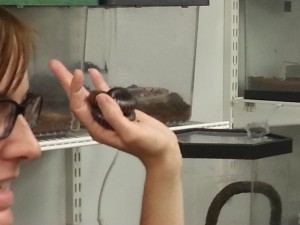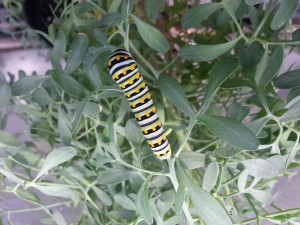My previous personal experience with insects and arthropods had generally devolved to how much harm can it inflict upon me, and how quickly can I kill it before it does so? This perspective immediately meant that I would rank each and every one that I’d encountered by the aforementioned categories. Which meant that while some like wasps would earn my undying respect and the fire ants a tip of the hat, millipedes and caterpillars would simply prove minor annoyances, something that cannot harm me and thus not worthy of my attention.
Man, was I wrong. On September 11th, our Insect Biology class strolled down to the Cockrell Butterfly Center at Houston Museum of Natural Science; this trip would turn out to truly open my eyes. While we did visit the Butterfly Center, we also got an exclusive tour of the exotic specimens that the Center’s biologists cultivated carefully.
Some of the species that immediately caught our eyes proved the Atlas beetle, a gigantic beetle with a huge horn that had a worse bark than bite ;
then came the giant African millipede, or Archispirostreptus gigas.
I apathetically turned my gaze toward the coiled creature, and I was not disappointed: this one would rank low in my book, perhaps even lower than the fruit fly. Shy and quiet, it lay immobile for quite a while until when it felt more comfortable and started crawling on our tour guide’s arms. 
“This one may appear scared and harmless, but do not be fooled: his exoskeleton proves very resilient and what’s worse, he excretes repugnatorial fluid that would make you regret your decision to harm him,” quipped Erin, our tour guide, as a student tried to touch the millipede.
Apparently this fluid, produced by these millipedes just for the sake of repelling potential predators, consists of quinos and hydrochloric acid, which is a powerful acid that can burn through human skin with ease.
But this center had more surprises in store for me: afterward, we decided actually see the butterflies, which are what the center is known for, after all. Upstairs, we stepped into a somewhat humid cage that the butterflies were kept and bred in; and upon a potted plant lay quite a large caterpillar.
Erin happily explained that this caterpillar was Papilio polyxenes, or the larvae of a black swallowtail butterfly. Apparently the larvae can have two colorations and ours was a bright green, with black stripes and yellow dots over the entire length of itself.
And once again I couldn’t help but feel slightly bored: this caterpillar literally resembled a harmless, pathetic living being and I wondered to myself how this particular butterfly species could possibly progress past this vulnerable stage to metamorphose?
Of course, as though she were reading my thoughts, Erin helpfully chimed in:
“So these caterpillars might look vulnerable, but when you bother them- (and she started stroking the caterpillar repeatedly)- they will expel foul chemicals that will smell horribly to its predators.”
And fair enough, there was a trace of a foreign smell lingering in the air, and it certainly did not smell like roses. This smell, emitted from an orange forked “horn” on its head called osmeterium, will capably repel birds and other predators.
To conclude, that day was when I realized that I should not allow outer appearances to leave preconceived notions in my head that are not necessarily true, given how complex biological systems can be. And that I wouldn’t want to rub a caterpillar the wrong way.
